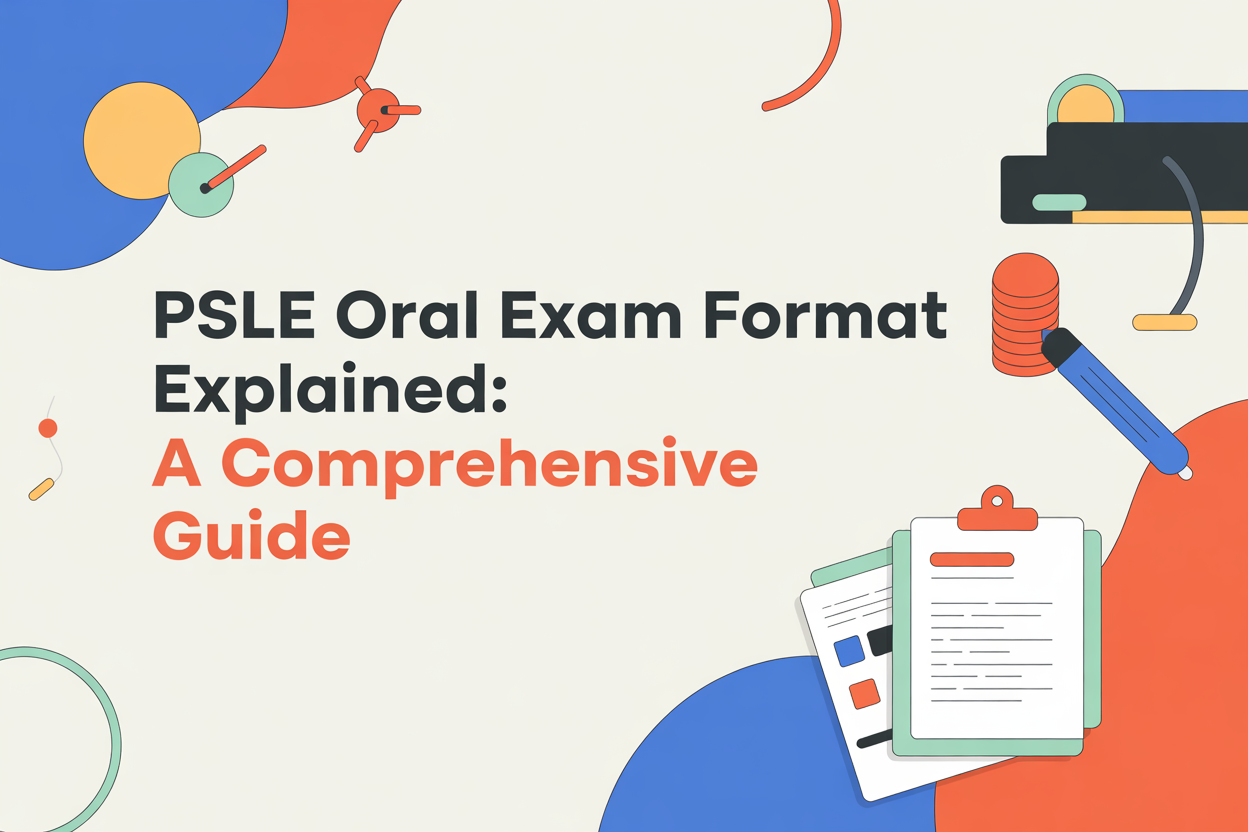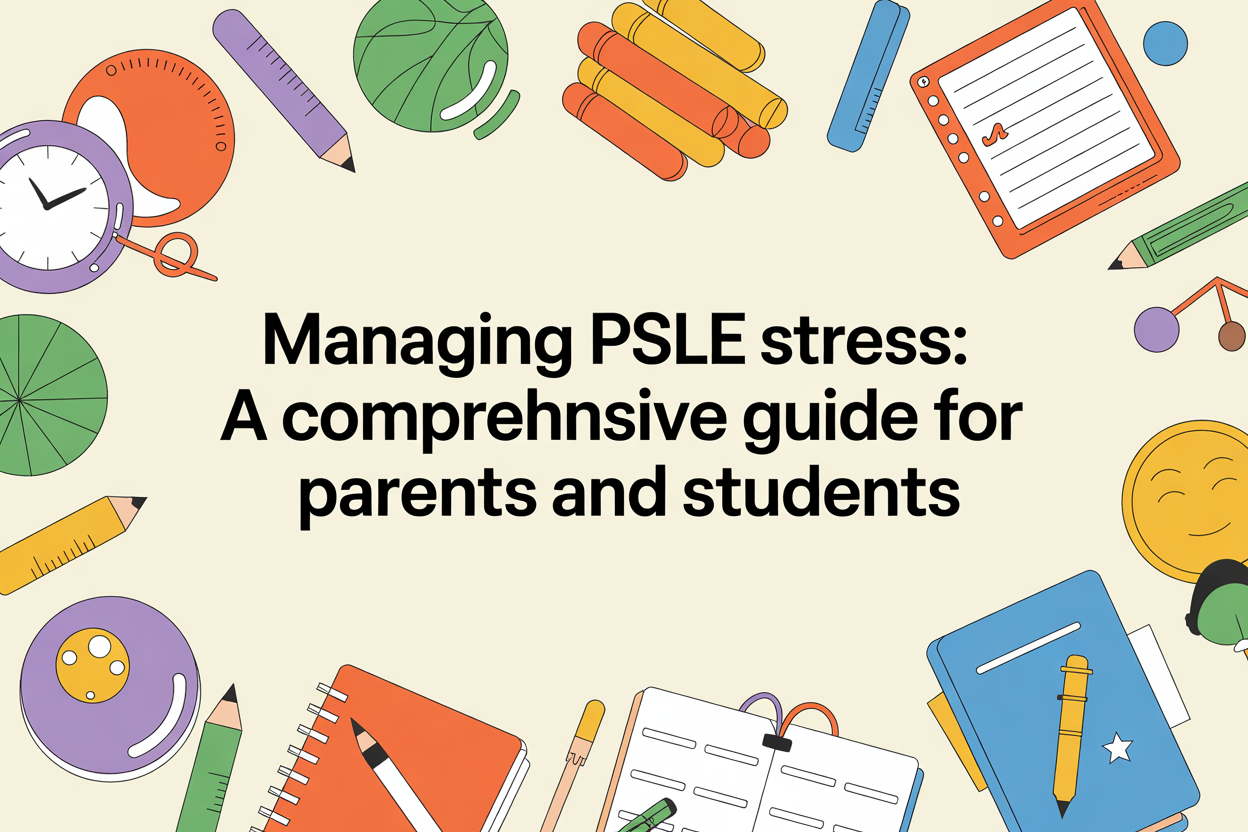- May 6, 2025 -
PSLE Oral Exam Format Explained: A Comprehensive Guide

Table of Contents
- Overview of the PSLE English Oral Examination
- Reading Aloud Component: Format and Preparation
- Stimulus-based Conversation Component: Mastering the Challenge
- PSLE Oral Exam: Updates for 2025
- Preparation Timeline: When and How to Practice
- Common Mistakes and How to Avoid Them
- The Role of Parental Support in Oral Exam Preparation
- How EduFirst Prepares Students for PSLE Oral Success
PSLE Oral Exam Format Explained: A Comprehensive Guide
The Primary School Leaving Examination (PSLE) marks a crucial milestone in every Singaporean student’s educational journey. Among its components, the oral examination often causes significant anxiety for students and parents alike. Understanding the exact format and expectations of the PSLE Oral Exam is the first step toward effective preparation and success.
This comprehensive guide unpacks the PSLE Oral Exam format, with updated information for 2025. Whether you’re a parent supporting your child or a student preparing for this important assessment, you’ll gain clarity on what to expect and how to prepare effectively.
Overview of the PSLE English Oral Examination
The PSLE English Oral Examination constitutes 15% of the total English Language grade, making it a significant component that can influence overall results. The examination consists of two main parts: Reading Aloud and Stimulus-based Conversation.
During the examination, students enter the examination room individually and face two examiners. The entire assessment typically lasts about 10 minutes per student, with each component being equally weighted in the oral examination score.
Students receive their examination materials about 10 minutes before their actual assessment, giving them time to prepare. This preparation time is crucial and should be used strategically to familiarize oneself with the passage and visual stimulus.
The oral examination tests multiple language skills simultaneously: pronunciation, articulation, intonation, expression, comprehension, and the ability to express thoughts clearly and coherently. Success requires not just language proficiency but also confidence and the ability to think on one’s feet.
Reading Aloud Component: Format and Preparation
What to Expect
In the Reading Aloud component, students receive a short passage of approximately 150 words. The passage typically contains narrative elements, dialogue, or descriptive language that allows students to demonstrate their reading skills.
Students are given about 5 minutes during the preparation time to read through the passage silently and prepare for their reading aloud. During the actual assessment, students must read the entire passage clearly to the examiners.
Scoring Criteria
Examiners evaluate students based on several key criteria:
Pronunciation and Articulation: Students should pronounce words correctly and articulate sounds clearly. Common challenges include consonant clusters, word endings, and unfamiliar vocabulary.
Rhythm and Fluency: Reading should be smooth and natural-sounding, not choppy or word-by-word. Students should maintain appropriate pace throughout.
Expression and Intonation: This involves using appropriate stress on words, varying pitch to convey meaning, and expressing emotion suitable to the content. The reading should sound natural and engaging, not monotonous.
Attention to Punctuation: Students must observe punctuation marks appropriately, pausing at commas and periods, and using suitable intonation for question marks and exclamation points.
Effective Preparation Strategies
Preparing for the Reading Aloud component requires consistent practice and attention to detail:
Regular Reading Practice: Students should read aloud for at least 15-20 minutes daily, using various text types similar to those in the PSLE.
Recording and Self-evaluation: Recording one’s reading and listening critically helps identify areas for improvement that might otherwise go unnoticed.
Vocabulary Building: Expanding vocabulary reduces encounters with unfamiliar words during the examination. Students should keep a vocabulary journal and learn the pronunciation of new words.
Punctuation Awareness: Practice reading with exaggerated attention to punctuation helps develop natural pausing and intonation patterns that eventually become automatic.
Seeking Feedback: Regular feedback from teachers, parents, or tutors provides valuable insights for improvement. At EduFirst Learning Centre, our small class sizes ensure that each student receives personalized feedback on their reading skills.
Stimulus-based Conversation Component: Mastering the Challenge
Format and Expectations
The Stimulus-based Conversation component involves responding to visual stimuli, typically pictures depicting situations, activities, or scenarios. Students receive a visual stimulus during their preparation time and must be ready to engage in a conversation about it with the examiners.
The conversation usually begins with simple questions about what the student observes in the picture, then progresses to more complex questions requiring interpretation, inference, personal response, or connection to real-life experiences.
A typical conversation might last 3-5 minutes, during which students must demonstrate their ability to understand the questions, provide relevant and developed responses, and engage naturally in the conversation.
Types of Visual Stimuli
Visual stimuli in the PSLE Oral Exam typically include:
Social Situations: People interacting in various settings like schools, parks, or community spaces.
Problem Scenarios: Situations depicting social or environmental issues like littering, disagreements, or resource conservation.
Sequential Pictures: A series of images telling a story or showing a process, requiring students to understand the sequence and relationships.
Everyday Activities: Common activities like shopping, playing sports, studying, or participating in cultural events.
Scoring Criteria
Examiners assess students on several key aspects during the conversation:
Comprehension: Understanding the questions asked and the visual stimulus presented.
Content Development: Providing relevant, detailed responses that show depth of thought rather than superficial observations.
Vocabulary and Expression: Using varied, precise vocabulary and expressing ideas clearly and coherently.
Grammar and Structure: Speaking with grammatical accuracy and appropriate sentence structures.
Interactive Ability: Engaging naturally in the conversation, responding appropriately to follow-up questions, and showing ability to expand on ideas.
Effective Response Strategies
To excel in the Stimulus-based Conversation, students should master these strategies:
Observation Technique: Develop a systematic approach to analyzing visual stimuli by noting who is involved, what they’re doing, where and when the scene takes place, and why the action might be happening.
PEEL Response Structure: Point (make a clear statement), Explain (elaborate on the point), Example (provide specific details from the picture or personal experience), Link (connect to broader themes or other ideas).
Vocabulary Enhancement: Build a repertoire of descriptive words, emotion words, action verbs, and connectors to express ideas more vividly and cohesively.
Question Anticipation: Practice predicting and preparing for different types of questions related to various stimuli, particularly those requiring personal opinions or solutions to problems.
Active Listening: Focus on understanding the examiner’s questions fully before responding, and be prepared to adapt responses based on the direction of the conversation.
PSLE Oral Exam: Updates for 2025
The Singapore Ministry of Education periodically reviews and updates examination formats to ensure they remain relevant and effectively assess student capabilities. For 2025, the PSLE Oral Exam maintains its core structure of Reading Aloud and Stimulus-based Conversation, with some refinements to assessment criteria and implementation.
What Remains the Same
The fundamental format continues to include:
– Two main components: Reading Aloud and Stimulus-based Conversation
– Equal weighting between the two components
– Individual assessment by two examiners
– Preparation time before the actual assessment
– 15% contribution to the overall English Language grade
Enhanced Focus Areas
While maintaining the established format, the 2025 assessment places increased emphasis on:
Critical Thinking: Questions in the Stimulus-based Conversation increasingly require students to analyze situations critically and offer reasoned perspectives.
Application to Real-world Contexts: Students are expected to make more connections between the visual stimuli and real-life situations, demonstrating their ability to apply language in authentic contexts.
Conversational Fluency: There’s greater emphasis on natural conversation flow rather than formulaic responses, encouraging students to engage more authentically with examiners.
Digital Literacy Integration: Some visual stimuli may include scenarios involving technology and digital communication, reflecting their increasing relevance in students’ lives.
Implications for Preparation
These refinements suggest several adjustments to preparation approaches:
Diverse Reading Materials: Expose students to a wider range of text types, including those with contemporary contexts and vocabulary.
Discussion-based Practice: Increase opportunities for students to engage in open-ended discussions about various topics, emphasizing depth of thought and clarity of expression.
Current Affairs Awareness: Familiarize students with age-appropriate current issues to help them make relevant connections during the Stimulus-based Conversation.
Authentic Communication: Focus on developing genuine communicative ability rather than memorized phrases or templates, encouraging students to express themselves naturally.
Preparation Timeline: When and How to Practice
Long-term Preparation (12-18 months before)
Effective preparation for the PSLE Oral Exam begins well in advance, ideally in Primary 5:
Foundation Building: Focus on developing general reading fluency and speaking confidence through regular reading aloud practice and casual conversations in English.
Vocabulary Expansion: Begin systematic vocabulary building through wide reading and keeping a vocabulary journal with pronunciation notes.
Media Exposure: Increase exposure to quality English media including audiobooks, documentaries, and news programs suitable for primary level students.
Basic Observation Skills: Start practicing simple picture description using everyday images, focusing on accurate observation and basic inference.
Medium-term Preparation (6-12 months before)
As students progress through Primary 6, preparation becomes more focused:
Structured Practice: Implement regular weekly practice sessions specifically targeting PSLE oral formats, gradually increasing frequency.
Targeted Feedback: Seek specific feedback on pronunciation, intonation, content development, and response structure from teachers or tutors.
Response Development: Work on elaborating answers and developing the ability to provide extended responses with examples and explanations.
Mock Examinations: Begin simulating examination conditions, including timed preparation periods and formal assessment settings.
Short-term Preparation (1-3 months before)
In the final months leading to the PSLE:
Intensive Practice: Increase practice frequency to several sessions per week, using past-year materials or similar resources.
Refinement: Focus on fine-tuning specific areas of weakness identified through practice assessments.
Stress Management: Incorporate strategies for managing nervousness and maintaining composure during the examination.
Examination Strategy: Develop a clear routine for using preparation time effectively, including approaches for unfamiliar words or challenging stimuli.
At EduFirst Learning Centre, our PSLE English preparation programs are structured to support this progressive development, with specialized oral examination practice integrated at appropriate stages throughout Primary 5 and 6.
Common Mistakes and How to Avoid Them
Reading Aloud Pitfalls
Many students encounter these challenges when reading aloud:
Word-by-word Reading: This creates a choppy, unnatural flow that disrupts meaning and reduces comprehension.
Solution: Practice reading in meaningful phrases or “chunks” rather than individual words. Mark text into logical groups during preparation time.
Monotonous Delivery: Reading without appropriate expression or intonation variation makes the content dull and difficult to follow.
Solution: Analyze the emotional content of passages and mark points where tone should change. Practice “performing” the text rather than just reading it.
Mispronunciation of Common Words: Certain words consistently cause problems, especially those with silent letters or unusual spelling patterns.
Solution: Create a personal list of commonly mispronounced words and practice them regularly. Use online pronunciation resources to hear correct pronunciations.
Ignoring Punctuation: Failing to observe commas, periods, and other punctuation marks disrupts the natural rhythm and meaning of the text.
Solution: Exaggerate punctuation during practice by counting brief pauses for commas and longer ones for periods. Gradually make these pauses more natural.
Conversation Component Challenges
In the Stimulus-based Conversation, students often struggle with:
Surface-level Observations: Merely describing what is visibly happening without deeper inference or interpretation.
Solution: Develop the habit of moving beyond “what” to “why” and “how” in observations. Practice explaining motivations, emotions, and implications in visual stimuli.
Brief, Undeveloped Responses: Giving short, minimal answers that don’t demonstrate language ability or critical thinking.
Solution: Use the PEEL structure (Point, Explain, Example, Link) to develop comprehensive responses. Practice extending answers with relevant details and examples.
Memorized Scripts: Reciting prepared answers that may not actually address the specific question asked.
Solution: Focus on understanding question types rather than memorizing answers. Practice responding naturally to varied questions about the same stimulus.
Limited Vocabulary: Using basic or repetitive language that doesn’t showcase language proficiency.
Solution: Build thematic vocabulary lists for common stimulus topics. Practice incorporating precise descriptive words, varied verbs, and appropriate idioms.
Examination Anxiety Management
Even well-prepared students can underperform due to nervousness:
Physical Manifestations: Speaking too quickly, voice trembling, or experiencing breathing difficulties during the examination.
Solution: Practice deep breathing techniques and incorporate them into regular oral practice. Develop pre-examination routines that include calming strategies.
Mental Blocks: Forgetting prepared ideas or struggling to process questions when under pressure.
Solution: Conduct multiple practice sessions under examination-like conditions to build resilience. Develop recovery strategies for momentary lapses, such as polite requests for clarification.
Perfectionism: Becoming overly concerned about mistakes, leading to increased anxiety and more errors.
Solution: Practice continuing confidently after making errors rather than dwelling on them. Focus on communication effectiveness rather than flawlessness.
At EduFirst Learning Centre, our experienced teachers help students identify their specific challenges and develop personalized strategies to overcome them, ensuring confidence and competence on examination day.
The Role of Parental Support in Oral Exam Preparation
Parents play a crucial role in supporting their children’s preparation for the PSLE Oral Examination. Effective support goes beyond organizing tuition; it involves creating an environment that nurtures language development and confidence.
Creating a Language-Rich Home Environment
Daily Conversations: Engage in regular, extended conversations in English about varied topics, encouraging your child to express opinions and ideas fully.
Family Reading Routines: Establish regular family reading sessions where family members take turns reading aloud, providing a natural context for reading practice.
Quality Media Selection: Curate age-appropriate English-language media including audiobooks, podcasts, documentaries, and news programs that expose children to diverse vocabulary and speaking styles.
Language Games: Incorporate word games, debates, storytelling activities, and description challenges into family time to make language practice enjoyable.
Structured Practice Support
Preparation Material Selection: Help source quality practice materials, including appropriate reading passages and visual stimuli similar to those used in PSLE.
Consistent Practice Schedule: Establish a regular practice routine that fits into your child’s overall study schedule without causing burnout.
Constructive Feedback: Learn to provide balanced feedback that acknowledges strengths while gently highlighting areas for improvement.
Mock Examinations: Periodically create more formal practice situations that simulate examination conditions, including having another adult serve as the “examiner.”
Emotional and Psychological Support
Anxiety Management: Help your child develop strategies for managing examination anxiety through breathing exercises, positive visualization, and preparation routines.
Building Confidence: Celebrate improvements and successes, however small, to build confidence gradually over time.
Balanced Expectations: Maintain realistic expectations that encourage effort without creating undue pressure or linking self-worth to performance.
Resilience Development: Help your child view mistakes as learning opportunities rather than failures, fostering a growth mindset toward language development.
Remember that consistent, positive support is more effective than intensive last-minute preparation. By creating regular opportunities for language practice within family life, parents can significantly enhance their child’s oral examination readiness while nurturing a lifelong appreciation for effective communication.
How EduFirst Prepares Students for PSLE Oral Success
At EduFirst Learning Centre, we’ve developed a comprehensive approach to PSLE Oral Examination preparation that leverages our strengths in personalized education and small class sizes.
Personalized Assessment and Planning
Our PSLE English preparation begins with detailed individual assessments that identify each student’s specific strengths and challenges in oral communication. This allows our teachers to develop personalized improvement plans that target the most impactful areas for each child.
With our small class sizes of just 4-8 students, we ensure that every student receives individual attention during each session. This allows for significantly more speaking practice and personalized feedback than is possible in larger classes.
Comprehensive Skill Development
Our curriculum systematically builds all the components required for oral examination success:
Pronunciation Refinement: Targeted exercises address specific pronunciation challenges common among Singaporean students, with particular attention to commonly mispronounced words and sound patterns.
Expressive Reading: Specialized techniques for developing natural intonation, appropriate pacing, and meaningful expression when reading aloud.
Visual Analysis Frameworks: Structured approaches to interpreting visual stimuli that move students beyond surface observations to deeper analysis and personal connection.
Response Construction: Practical frameworks for building comprehensive, well-organized responses that demonstrate language proficiency and critical thinking.
Conversational Fluency: Interactive activities that develop the ability to engage naturally in examiner-led conversations, responding appropriately to various question types.
Authentic Practice Opportunities
We believe that meaningful practice is key to examination confidence:
Simulated Examination Conditions: Regular practice under conditions that mirror the actual PSLE setting, including timed preparation periods and formal assessment protocols.
Diverse Stimulus Materials: Exposure to a wide range of reading passages and visual stimuli that reflect the variety students might encounter in the actual examination.
Video Recording and Analysis: Periodic recording of practice sessions allows students to observe their own performance objectively and track improvement over time.
Peer Learning Opportunities: Structured activities where students learn from observing peers and providing constructive feedback, developing critical awareness of effective communication.
Confidence Building and Anxiety Management
We recognize that performance anxiety can significantly impact oral examination results:
Progressive Exposure: Gradually increasing the formality of practice situations helps students build comfort with the examination format without overwhelming them.
Positive Reinforcement: Our teachers emphasize progress and specific strengths while constructively addressing areas for improvement.
Practical Coping Strategies: Students learn concrete techniques for managing nervousness, recovering from errors, and maintaining composure during the examination.
Regular Success Experiences: Carefully calibrated challenges ensure that students regularly experience success, building confidence incrementally.
With 25 locations islandwide, EduFirst Learning Centre offers convenient access to our proven PSLE preparation programs. Our track record of helping students achieve significant improvements in their oral communication skills reflects our commitment to personalized education that produces results.
Conclusion
The PSLE Oral Examination tests not just language proficiency but also the ability to communicate effectively under pressure—a valuable life skill that extends far beyond the examination room. By understanding the format thoroughly and preparing systematically, students can approach this component with confidence and showcase their true capabilities.
The 2025 PSLE Oral Exam maintains its focus on reading aloud and stimulus-based conversation while emphasizing critical thinking, real-world application, and natural communication. Effective preparation combines technical skill development with confidence building and regular, meaningful practice.
Remember that oral communication skills develop gradually through consistent practice and constructive feedback. Starting preparation early, maintaining a regular practice schedule, and seeking appropriate support are key to steady improvement and examination success.
Parents play a vital role in this process by creating language-rich home environments, providing structured practice opportunities, and offering emotional support throughout the preparation journey.
With the right guidance and preparation approach, students can transform the PSLE Oral Examination from a source of anxiety to an opportunity to demonstrate their communication abilities with confidence and competence.
Ready to Help Your Child Excel in PSLE Oral Examination?
At EduFirst Learning Centre, our experienced teachers provide personalized guidance in small classes of just 4-8 students, ensuring your child receives the individual attention needed to develop strong oral communication skills.
With 25 convenient locations across Singapore, expert teachers, and a proven track record of PSLE success, we’re here to support your child’s journey to confidence and competence in the oral examination.
Contact us today to learn more about our PSLE English preparation programs or to schedule an assessment for your child.



